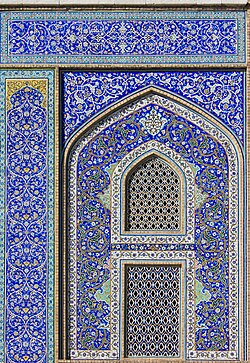Isfahani style
| Isfahan city |
|---|
 |
The "Esfahani" or "Isfahani style" (شیوه معماری اصفهانی) is a style of architecture (sabk) defined by Mohammad Karim Pirnia when categorizing Iranian architecture development in history. Landmarks of this style span through the Safavid, Afsharid, Zand, and Qajar dynasties starting from the 16th century to the early 20th century.[1]
The Isfahani style is the last style of traditional Persian–Iranian architecture.[2]
The Safavid dynasty were chiefly instrumental in the emergence of this architectural style, which soon spread to India in what became known as Mughal architecture.
Examples[]
Examples of the Isfahani style include:
- Chehelsotoon
- Ali Qapu
- Agha Bozorg Mosque, Kashan
- Shah Mosque
- Sheikh Lotf Allah Mosque.
See also[]
- Isfahan
- Iranian architecture
- List of the historical structures in the Isfahan province
Gallery[]

The mosque of Isfahan international conference center

Hasht Behesht palace

Imam Mosque, Isfahan
References[]
- ^ Fallāḥʹfar, Saʻīd (سعید فلاحفر). The Dictionary of Iranian Traditional Architectural Terms (Farhang-i vāzhahʹhā-yi miʻmārī-i sunnatī-i Īrān فرهنگ واژههای معماری سنتی ایران). Kamyab Publications (انتشارات کامیاب). Kāvushʹpardāz. 2000, 2010. Tehran. ISBN 978-964-2665-60-0 US Library of Congress LCCN Permalink: [1] pp.26
- ^ Sabk Shenasi Mi'mari Irani (Study of styles in Iranian architecture), M. Karim Pirnia. 2005. ISBN 964-96113-2-0 pp.272
External links[]
Categories:
- Architecture of Iran
- Safavid architecture





